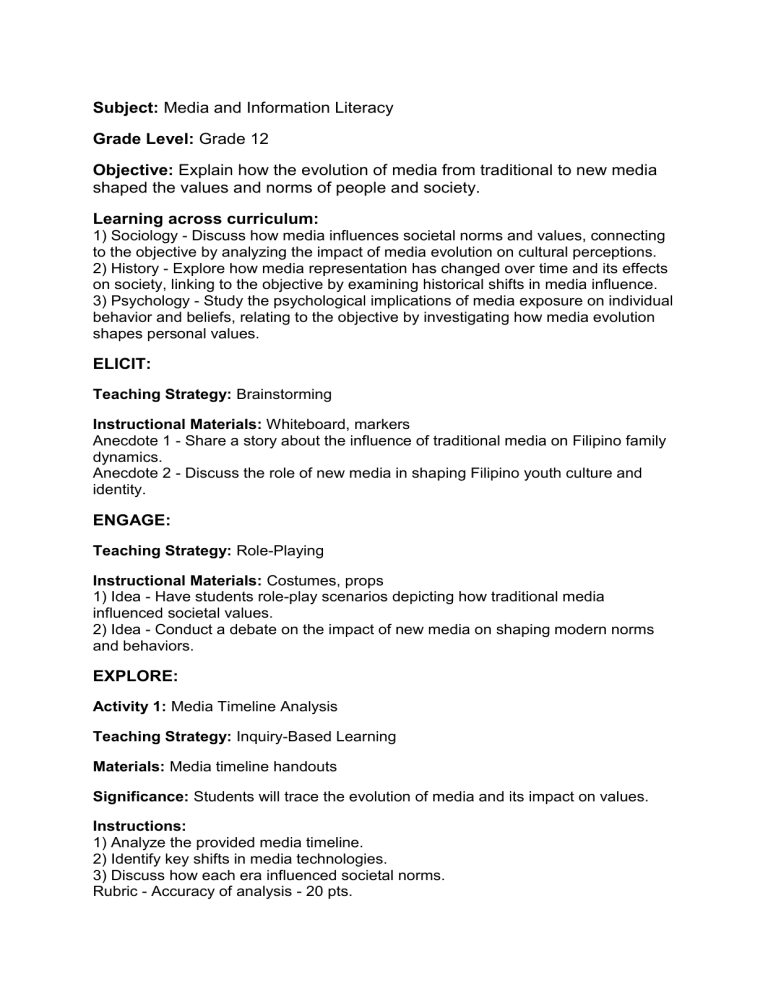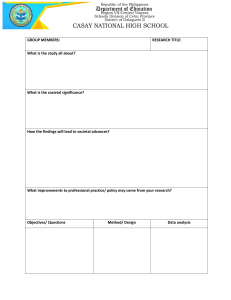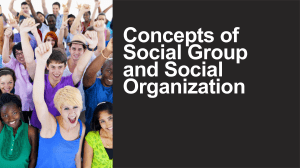
Subject: Media and Information Literacy Grade Level: Grade 12 Objective: Explain how the evolution of media from traditional to new media shaped the values and norms of people and society. Learning across curriculum: 1) Sociology - Discuss how media influences societal norms and values, connecting to the objective by analyzing the impact of media evolution on cultural perceptions. 2) History - Explore how media representation has changed over time and its effects on society, linking to the objective by examining historical shifts in media influence. 3) Psychology - Study the psychological implications of media exposure on individual behavior and beliefs, relating to the objective by investigating how media evolution shapes personal values. ELICIT: Teaching Strategy: Brainstorming Instructional Materials: Whiteboard, markers Anecdote 1 - Share a story about the influence of traditional media on Filipino family dynamics. Anecdote 2 - Discuss the role of new media in shaping Filipino youth culture and identity. ENGAGE: Teaching Strategy: Role-Playing Instructional Materials: Costumes, props 1) Idea - Have students role-play scenarios depicting how traditional media influenced societal values. 2) Idea - Conduct a debate on the impact of new media on shaping modern norms and behaviors. EXPLORE: Activity 1: Media Timeline Analysis Teaching Strategy: Inquiry-Based Learning Materials: Media timeline handouts Significance: Students will trace the evolution of media and its impact on values. Instructions: 1) Analyze the provided media timeline. 2) Identify key shifts in media technologies. 3) Discuss how each era influenced societal norms. Rubric - Accuracy of analysis - 20 pts. Assessment Questions: 1) How did traditional media differ from new media in shaping societal values? 2) Discuss a specific event in history where media played a significant role in changing societal norms. 3) How can media literacy help individuals navigate the influence of new media on personal values? EXPLAIN: Teaching Strategy: Lecture Provide a detailed explanation of how media evolution from traditional to new media has shaped societal values and norms, encouraging student interaction and questions. ELABORATE: Teaching Strategy: Project-Based Learning Task 1 - Create a social media campaign highlighting the positive impact of media literacy on shaping critical thinking skills. Task 2 - Conduct a survey among peers to assess the influence of new media on their values and beliefs. EVALUATE: Teaching Strategy: Discussion Instructional Materials: Assessment rubric Question 1 - How has media portrayal of gender roles evolved from traditional to new media? Question 2 - Discuss the role of social media influencers in shaping societal norms. Question 3 - In what ways can media literacy education promote responsible consumption of new media content? EXTEND: Teaching Strategy: Case Studies Instructional Materials: Case study scenarios Encourage students to apply media literacy concepts to real-world situations and analyze how media influences values and behaviors in diverse contexts. Assignment: 1) Analytical Essay Guiding Overview: Students will write an essay analyzing the impact of new media on cultural values, supported by examples and research. Assessment Question: How has the evolution of media influenced societal norms and values in the digital age? 2) Media Consumption Log Guiding Overview: Students will maintain a log tracking their media consumption habits and reflect on how it shapes their perspectives and values. Assessment Question: Reflect on the media content you consumed this week and discuss its influence on your beliefs and behaviors.


